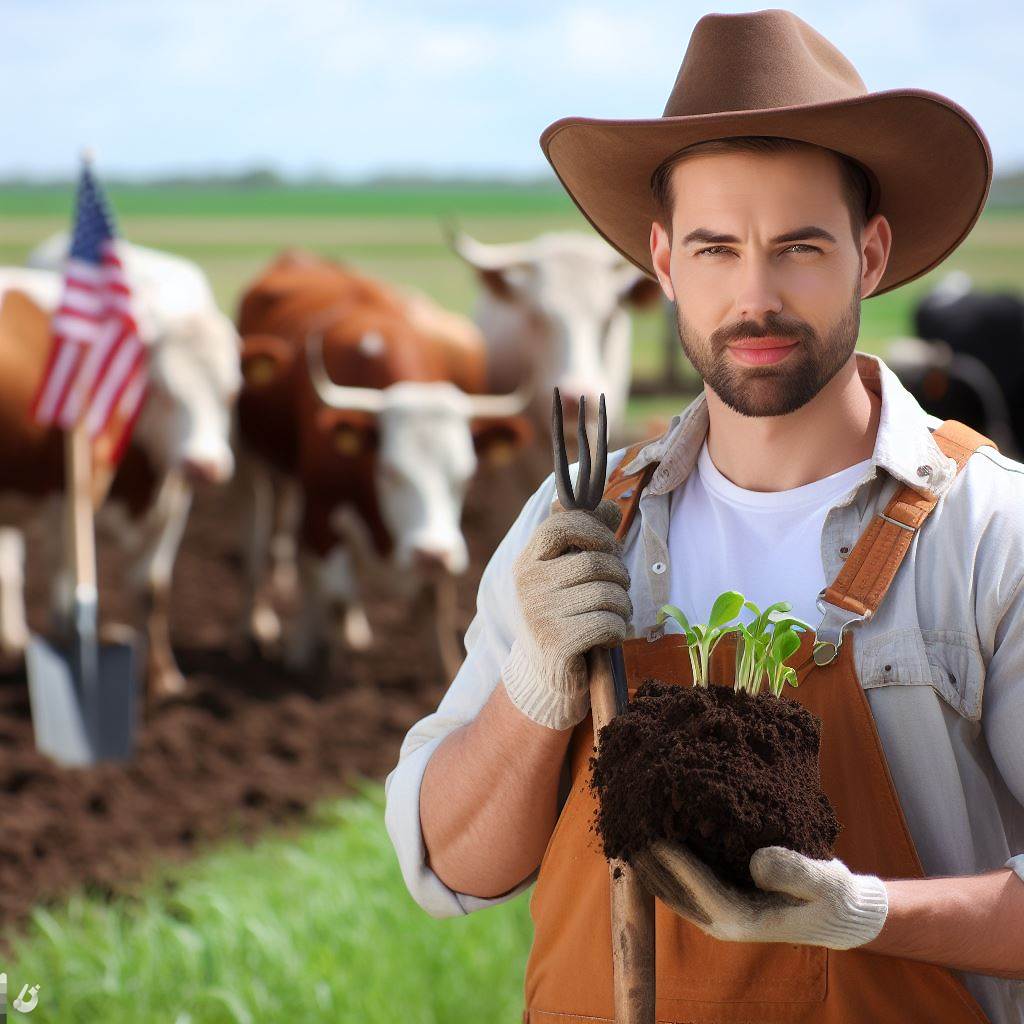Introduction
“Harvest Tales: Life in the Wheat Fields” explores the experiences of individuals in the wheat farming community.
The wheat harvest season holds great importance for farmers, as it signifies the culmination of their hard work.
In the vast expanse of golden wheat fields, where the sun-kissed grains sway like a sea of amber waves, a symphony of life unfolds.
This is the canvas upon which the timeless narrative of harvest tales is painted—the chronicles of toil, triumph, and the rich tapestry of existence woven in the heart of wheat farming.
As we step into this realm, we embark on a journey through the fields that sustain nations, exploring the pulsating life that ebbs and flows with the seasons.
From the moment the first green shoots emerge to the rhythmic dance of the wind through mature wheat, each stage in the life cycle tells a story.
Farmers, custodians of this living landscape, invest sweat and passion, navigating the challenges and celebrating the victories.
Harvest tales encapsulate the essence of rural life, weaving a narrative that extends beyond agriculture, touching the very core of human connection, resilience, and the cyclical beauty of nature.
This exploration transcends the mere act of cultivation; it ventures into the soul of wheat farming, where traditions meld with modernity, and each harvest becomes a testament to human ingenuity.
Join us as we delve into the heart of harvest tales, immersing ourselves in the symphony of rural existence played out amidst the rustling wheat fields, where the land breathes life into stories that echo through generations.
The purpose of this blog post is to provide an in-depth understanding of the wheat harvest season and its impact.
Historical Background of Wheat Harvest
Historical Perspective on the Importance of Wheat Agriculture
Wheat agriculture has played a crucial role in human civilization for thousands of years.
Dating back to the Neolithic period, wheat cultivation marked the transition from hunter-gatherer societies.
The domestication of wheat provided a stable food source, leading to the establishment of settled communities.
Throughout history, wheat has been a staple crop, vital for sustenance and economic stability.
Transform Your Agribusiness
Unlock your farm's potential with expert advice tailored to your needs. Get actionable steps that drive real results.
Get StartedFrom ancient civilizations such as Mesopotamia and Egypt to medieval Europe, wheat shaped societies and economies.
Wheat agriculture formed the backbone of agrarian societies, influencing cultural practices and socioeconomic systems.
The cultivation of wheat enabled population growth, trade networks, and the rise of urban centers.
Wheat also holds symbolic and religious significance, representing nourishment and abundance in diverse cultures.
Evolution of Wheat Harvesting Techniques Over Time
early humans harvested wheat by hand, using simple tools like sickles and scythes.
These hand tools required manual labor and limited the amount of wheat that could be harvested.
With the invention of the first mechanical reaper by Cyrus McCormick in the 19th century, wheat harvesting underwent a revolution
The mechanical reaper increased efficiency by cutting and gathering wheat simultaneously.
Subsequent advancements introduced combine harvesters, which further expedited the process by integrating harvesting and threshing.
Modern combine harvesters utilize advanced technologies like GPS and sensors to optimize precision and yield.
Throughout history, the evolution of harvesting techniques has enabled larger-scale and more efficient wheat production.
These advancements have significantly impacted the agricultural industry, improving productivity and reducing labor requirements.
Impact of Technological Advancements on Wheat Farming
- Technological advancements have revolutionized wheat farming, enhancing both efficiency and sustainability.
- The invention of irrigation systems allowed farmers to cultivate wheat in arid regions, expanding agricultural lands.
- Introduction of chemical fertilizers and pesticides increased crop yields, ensuring food security amidst growing populations.
- Genetic engineering has also played a significant role, developing high-yield and disease-resistant wheat varieties.
- Modern farming practices, such as precision agriculture and data-driven decision-making, optimize resource utilization.
- Automation and robotics have further transformed wheat farming by reducing dependency on manual labor.
- These technological advancements have not only boosted productivity but also reduced environmental impacts.
- Sustainable practices like conservation tillage and precision application of inputs help preserve soil health and minimize waste.
In fact, the historical background of wheat harvest highlights its importance throughout human civilization.
Wheat agriculture has shaped societies, economies, and cultural practices.
The evolution of wheat harvesting techniques, from simple hand tools to modern combine harvesters, has improved efficiency and productivity.
Technological advancements, such as irrigation systems, fertilizers, and genetic engineering, have further revolutionized wheat farming.
With the integration of automation, robotics, and sustainable practices, wheat agriculture continues to adapt and thrive in the modern world.
Read: Hops and Dreams: The Craft Beer Farmer
Life on a Wheat Farm during Harvest
The typical day-to-day activities during the wheat harvest season
- Waking up before sunrise, farmers prepare themselves for a long day in the wheat fields.
- They gather their tools, check their machinery, and ensure that everything is in working order.
- As the sun rises, they begin their work, carefully cutting the wheat stalks and collecting them.
- The harvested wheat is then transported and stored in large bins or grain elevators.
- Throughout the day, the farmers continuously monitor the equipment to avoid any breakdowns or delays.
- Lunch breaks are brief, as time is of the essence during the harvest season.
- Once the sun sets, the farmers finally wrap up their day, exhausted but satisfied with their hard work.
The challenges faced by farmers during this busy time
- Unpredictable weather conditions such as sudden rainstorms or heatwaves can disrupt the harvest process.
- Equipment malfunctions and breakdowns can cause costly delays and hinder the progress of harvesting.
- Finding enough labor force to assist with the demanding workload during the harvest season can be a challenge.|
- Managing logistics, including transportation and storage, requires careful planning and coordination.
- The pressure to harvest quickly to avoid potential crop damage adds stress to the already busy time.
The role of the entire family in the wheat harvesting process
- The entire family becomes involved in the wheat harvest, working together to ensure a successful season.
- Children assist by helping with lighter tasks, such as gathering and bundling the cut wheat stalks.
- Spouses often take on administrative duties, managing paperwork and organizing schedules.
- The family provides emotional support, understanding the physical and mental demands of the harvest.
- Meals are prepared and brought to the fields, offering nourishment to keep the farmers energized.
Life on a wheat farm during harvest is a whirlwind of activity and dedication. From dawn till dusk, farmers pour their heart and soul into ensuring a bountiful harvest.
The typical day consists of early mornings, meticulous preparation, and continuous vigilance.
However, challenges are inevitable, with unpredictable weather and inevitable equipment malfunctions creating hurdles along the way.
The entire family plays a crucial role in the wheat harvesting process. Children learn the importance of hard work and contribute by assisting with lighter tasks.
Spouses provide valuable support by managing administrative duties, allowing the farmers to focus on their work.
The presence of the family creates a sense of unity and motivation throughout the season.
Showcase Your Farming Business
Publish your professional farming services profile on our blog for a one-time fee of $200 and reach a dedicated audience of farmers and agribusiness owners.
Publish Your ProfileAs the sun sets, exhaustion sets in, but there is also a deep sense of satisfaction. Farmers can take pride in their accomplishments and the fruits of their labor.
The wheat harvest is not just a job; it is a way of life, deeply ingrained in the agricultural fabric.
It is a testament to resilience, dedication, and the timeless bond between human beings and the land they cultivate.
Read: Dawn to Dusk: A Dairy Farmer Story

Tools and Machinery Used in Wheat Harvesting
Overview of Different Tools and Machinery Used in Wheat Farming
- Combine Harvesters
- Tractors
- Plows
- Seeders
- Harrows
- Threshers
- Grain Carts
- Grain Augers
- Grain Elevators
Purpose and Functionality of Each Tool or Machine
Combine Harvesters
These machines are used to reap, thresh, and winnow wheat in a single operation.
The combine harvester cuts the wheat stalks, separates the grains from the chaff, and collects the clean grains in a storage tank.
Tractors
Tractors are used for various tasks in wheat farming, such as plowing the fields, pulling other machinery, and transporting harvests.
They provide the necessary power and traction to perform these tasks efficiently.
Plows
Plows are used to prepare the soil for planting by turning it over and breaking it up.
This helps loosen the soil, making it easier for the seeds to germinate and grow.
Seeders
Seeders are machines that plant seeds into the prepared soil.
They distribute the seeds evenly, at the desired depth and spacing, ensuring optimal conditions for germination and crop growth.
Harrows
Harrows are implements with spikes or discs that are dragged over the soil to break up clods, level the surface, and remove weeds.
They help create a favorable environment for the crops by providing a smooth and weed-free field.
Threshers
Threshers are used to separate the grains from the harvested wheat stalks.
These machines beat or rub the harvested crop, dislodging the grains from their husks or heads.
Grain Carts
Grain carts are large wagons used to transport harvested grain from the field to storage areas or processing facilities.
They have high capacity and are designed to minimize damage to the grains during transportation.
Grain Augers
Grain augers are conveyor systems used to move grain from one location to another.
They consist of a rotating screw inside a tube, which lifts and carries the grain along the tube.
Grain Elevators
Grain elevators are tall structures equipped with conveyor belts, buckets, or other mechanisms to lift grain to higher levels.
They are used for temporary storage, cleaning, drying, and loading grain onto trucks or trains for transportation to markets.
Advancements Made in Agricultural Technology
- Precision Farming: The use of GPS, sensors, and data analysis to optimize crop production.
- Improved Machinery: Modern tools and machines are more efficient, precise, and automated.
- Hybrid Varieties: Development of wheat varieties with higher yields and improved disease resistance.
- Bioengineering: Genetic modifications to enhance wheat’s traits, such as herbicide tolerance or drought resistance.
- Remote Monitoring: Farmers can monitor their crops and machinery remotely through sensors and cameras.
These advancements have significantly increased productivity, reduced manual labor, and improved overall efficiency in wheat farming.
In general, a variety of tools and machinery are used in wheat farming, each serving a specific purpose.
These machines have evolved over time, becoming more advanced and efficient, leading to increased productivity and improved crop quality.
Additionally, breakthroughs in agricultural technology have revolutionized the way wheat is grown, monitored, and harvested.
With these advancements, farmers can embrace new techniques and technologies to enhance their wheat harvests and ensure a sustainable agricultural future.
Read: Agri-Insurance: Policy Changes in 2024
Shared Stories and Experiences
Collect and share personal stories from farmers and their families
Farmers and their families each have unique tales to tell about their experiences in the wheat fields.
Listening to their stories allows us to gain insights into the challenges and joys of farming.
Through interviews and conversations, we can understand the deep connection farmers have with their land.
These personal stories also shed light on the hard work and dedication required to sustain a farming livelihood.
Sharing these stories is important to create awareness and appreciation for the farming community.
Unique tales and experiences that capture the spirit of wheat harvest
Among the shared stories, there are those that stand out, embodying the essence of wheat harvest.
One such tale is the account of a farmer who persevered through a relentless heatwave to save his crops.
Another unique experience might be the story of a young child who spent summers on the wheat fields, learning the trade from their parents.
These tales often highlight the resilience, determination, and sense of community within the farming world.
By highlighting such stories, we celebrate the unwavering spirit and dedication of those involved in wheat harvest.
Illustrate the close-knit nature of the farming community through these stories
Through the shared stories and experiences, it becomes evident that the farming community is tightly interconnected.
Farmers often rely on one another during harvest, lending equipment or manpower when needed.
Showcase Your Farming Business
Publish your professional farming services profile on our blog for a one-time fee of $200 and reach a dedicated audience of farmers and agribusiness owners.
Publish Your ProfileThese stories reveal the unspoken camaraderie and support that exists within the farming community.
They demonstrate how acts of kindness and cooperation contribute to the success of wheat harvest.
By illustrating the close-knit nature of the farming community, we foster a greater sense of unity and appreciation.
In a nutshell, sharing personal stories from farmers and their families is an essential part of understanding the wheat harvest.
These stories provide insights into the challenges, joys, and close-knit nature of the farming community.
By highlighting unique tales and experiences, we capture the spirit of wheat harvest and celebrate the resilience and dedication of those involved.
Through these stories, we can create awareness and appreciation for the farming community and foster a sense of unity among all who appreciate the world of agriculture.
Read: Biofuel Policies: Effects on Crop Choices
Challenges and Rewards of Wheat Harvest
Challenges Faced During the Wheat Harvesting Season
- Unpredictable weather conditions often pose a significant challenge for farmers during the wheat harvest.
- Heavy rain and storms can delay harvesting, causing wheat to become overripe or even rot.
- Pests and diseases, such as rust and aphids, can destroy the wheat crop if not properly managed.
- Shortage of laborers during the harvest season adds to the challenges faced by farmers.
- High fuel and machinery costs contribute to the financial burden of farmers during the harvest.
Financial and Emotional Rewards of a Successful Harvest
- A successful wheat harvest brings a sense of accomplishment and pride to farmers who dedicated their efforts.
- Financially, a bountiful harvest can provide a stable income and improve the overall financial situation of the farm.
- A successful harvest allows farmers to repay debts, invest in new equipment, and expand their operations.
- Farmers also benefit emotionally from knowing they have contributed to feeding their community and the world.
- A good harvest fosters a sense of optimism and hope for the future of farming and agricultural practices.
Examples and Anecdotes
For many farmers, the challenges and rewards of the wheat harvest are deeply personal experiences:
John, a wheat farmer from Kansas, recalls a particularly challenging harvest season.
Due to excessive rainfall, his wheat fields were waterlogged, leading to poor quality grain.
Despite the setbacks, John’s determination and resilience kept him going.
On the other hand, Sarah, a third-generation wheat farmer, shares the immense satisfaction she and her family felt during a highly successful harvest.
The bumper crop not only improved their financial stability but also strengthened their bond as a farming community.
These examples highlight the unpredictable nature of agriculture and the resilience required to overcome challenges.
It is the unwavering spirit of farmers and their ability to adapt that eventually leads to the rewards of a successful harvest.
The challenges faced by farmers during the wheat harvesting season are significant but not insurmountable.
With dedication, hard work, and the support of their community, farmers can overcome the obstacles they encounter.
The financial and emotional rewards that come with a successful harvest make all the efforts worthwhile, solidifying the crucial role of agriculture in our society.
Conclusion
In this blog post, we explored the life in the wheat fields and harvest tales.
Harvest tales unfurl a vivid tapestry of life, intertwining sweat, determination, and the golden yields of wheat fields.
Wheat farming and the harvest season play a crucial role in our food supply and economies.
Wheat farming, a timeless saga, is more than cultivation; it’s a symphony of hard work yielding sustenance for all.
In this context wheat fields foster vibrant communities, knitting farmers, families, and consumers into the fabric of shared abundance.
The harvest season isn’t just a calendar event; it’s an economic powerhouse, driving prosperity in rural landscapes.
As the wheat rustles in the breeze, let’s savor these harvest tales. Join hands, appreciate our farmers, and nurture our shared grain-filled future.
As we conclude, let us appreciate the hard work of farmers and support sustainable agriculture to ensure a future with bountiful harvests.




